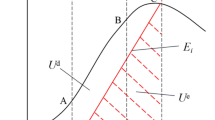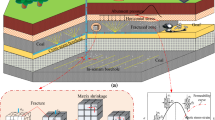Abstract
The mining of underground coal seam often induces the dynamic disasters of coal seam, such as rock burst and gas outburst. The determination of evolution characteristics of mechanical parameters and seepage parameters of coal mass after excavation is the basis for analyzing the formation mechanism of dynamic disasters. In this study, a coupled hydromechanical numerical approach is developed and their complex interactions are analyzed using the energy method to study the influence of outburst factors during underground excavation. A finite element model of porous media, which represents the gas flow field, the coal deformation field, the coal damage field and the cross-couplings between them, is established and the reliability of the model is ensured by numerical and experimental validation. Subsequently, during underground excavation, the coal deformation and gas flow properties around the borehole associated with different factors, including gas sorption, the matrix-fracture characteristics of coal and the seepage characteristics, are analyzed quantitatively using numerical simulations. Furthermore, an energy index is developed based on the energy method to analyze the comprehensive influence of in situ stress and gas pressure on coal mass. The results revealed that in the damage zone, coal permeability increases greatly by one to two orders of magnitude and the gas pressure remains low. Gas adsorption not only affects the stress and deformation of coal, but also affects the extent of the damage zone. High in situ stress, high gas pressure and low coal strength cause the failure range to increase.
















Similar content being viewed by others
References
An, F., & Cheng, Y. (2014). The effect of a tectonic stress field on coal and gas outbursts. The Scientific World Journal, 2014, 813063.
An, F. H., Cheng, Y. P., Wang, L., & Li, W. (2013). A numerical model for outburst including the effect of adsorbed gas on coal deformation and mechanical properties. Computers and Geotechnics, 54, 222–231.
Azadi, M., Aminossadati, S. M., & Chen, Z. (2016). Large-scale study of the effect of wellbore geometry on integrated reservoir-wellbore flow. Journal of Natural Gas Science & Engineering, 35, 320–330.
Beamish, B. B., & Crosdale, P. J. (1998). Instantaneous outbursts in underground coal mines: An overview and association with coal type. International Journal of Coal Geology, 35(1), 27–55.
Cai, C. G., & Xiong, Y. X. (2005). Theoretical and experimental study on crushing energy of outburst-proneness coal. Journal of the China Coal Society, 30(1), 63–66.
Cox, S. F. (2010). The application of failure mode diagrams for exploring the roles of fluid pressure and stress states in controlling styles of fracture-controlled permeability enhancement in faults and shear zones. Geofluids, 10(1–2), 217–233.
Farmer, I. W., & Pooley, F. D. (1967). A hypothesis to explain the occurrence of outbursts in coal, based on a study of west wales outburst coal. International Journal of Rock Mechanics & Mining Sciences & Geomechanics Abstracts, 4(2), 189–193.
Giger, S.B., Tenthorey, E., Cox, S.F., & Gerald, J.D.F. (2007). Permeability evolution in quartz fault gouges under hydrothermal conditions. Journal of Geophysical Research Solid Earth, 112(B7).
Gray, I. (1980). The mechanism of, and energy release associated with, outbursts. In Symposia series (pp. 111–125). Australasian Institute of Mining and Metallurgy.
He, P. F., Kulatilake, P. H., Liu, D. Q., He, M. C., & Chen, X. (2016). A procedure to detect, construct, quantify, numerically simulate and validate fracture networks in coal blocks. Geomechanics and Geophysics for Geo-Energy and Geo-Resources, 2(4), 257–274.
Jagiełło, J., Lasoń, M., & Nodzeński, A. (1992). Thermodynamic description of the process of gas liberation from a coal bed. Fuel, 71(4), 431–435.
Jiang, C. L., & Yu, Q. X. (1996). Rules of energy dissipation in coal and gas outburst. Journal of China Coal Society, 21(2), 173–178.
Jones, F. O., & Owens, W. W. (1980). A laboratory study of low-permeability gas sands. Journal of Petroleum Technology, 32(09), 1631–1640.
Li, D., Sun, Z., Xie, T., Li, X., & Ranjith, P. G. (2017). Energy evolution characteristics of hard rock during triaxial failure with different loading and unloading paths. Engineering Geology, 228, 270–281.
Li, D. J., Jia, X. N., Miao, J. L., He, M., & Li, D. (2010). Analysis of fractal characteristics of fragment from rockburst test of granite. Chinese Journal of Rock Mechanics and Engineering, 29(1), 3280–3289.
Li, L. C., Tang, C. A., Li, G., Wang, S. Y., Liang, Z. Z., & Zhang, Y. B. (2012). Numerical simulation of 3D hydraulic fracturing based on an improved flow-stress-damage model and a parallel FEM technique. Rock Mechanics and Rock Engineering, 45(5), 801–818.
Litwiniszyn, J. (1985). A model for the initiation of coal–gas outbursts. International Journal of Rock Mechanics and Mining Sciences & Geomechanics Abstracts, 22(1), 39–46.
Liu, H. H., Ranjith, P. G., Georgi, D. T., & Lai, B. T. (2016). Some key technical issues in modelling of gas transport process in shales: A review. Geomechanics and Geophysics for Geo-Energy and Geo-Resources, 2(4), 231–243.
Liu, Q., Cheng, Y., Zhou, H., Guo, P., An, F., & Chen, H. (2015). A mathematical model of coupled gas flow and coal deformation with gas diffusion and klinkenberg effects. Rock Mechanics and Rock Engineering, 48(3), 1163–1180.
Lu, Y. L., Elsworth, D., & Wang, L. G. (2013). Microcrack-based coupled damage and flow modeling of fracturing evolution in permeable brittle rocks. Computers and Geotechnics, 49, 226–244.
Lyu, Q., Long, X., Ranjith, P. G., Tan, J., & Kang, Y. (2018a). Experimental investigation on the mechanical behaviours of a low-clay shale under water-based fluids. Engineering Geology, 233, 124–138.
Lyu, Q., Long, X., Ranjith, P. G., Tan, J., Kang, Y., & Wang, Z. (2018b). Experimental investigation on the mechanical properties of a low-clay shale with different adsorption times in sub-/super-critical CO2. Energy, 147, 1288–1298.
Ma, T., Rutqvist, J., Oldenburg, C. M., Liu, W., & Chen, J. (2017). Fully coupled two-phase flow and poromechanics modeling of coalbed methane recovery: Impact of geomechanics on production rate. Journal of Natural Gas Science and Engineering, 45, 474–486.
Mahanta, B., Sirdesai, N., Singh, T. N., & Ranjith, P. G. (2017). Experimental study of strain rate sensitivity to fracture toughness of rock using flattened Brazilian disc. Procedia Engineering, 191, 256–262.
Olierook, H. K. H., Timms, N. E., & Hamilton, P. J. (2014). Mechanisms for permeability modification in the damage zone of a normal fault, northern Perth Basin. Western Australia. Marine & Petroleum Geology, 50(1), 130–147.
Otuonye, F., & Sheng, J. (1994). A numerical simulation of gas flow during coal/gas outbursts. Geotechnical and Geological Engineering, 12(1), 15–34.
Paterson, L. (1986). A model for outbursts in coal. International Journal of Rock Mechanics and Mining Sciences & Geomechanics Abstracts, 23(4), 327–332.
Rajabi, M., Tingay, M., King, R., & Heidbach, O. (2016). Present-day stress orientation in the Clarence–Moreton Basin of New South Wales, Australia: A new high density dataset reveals local stress rotations. Basin Research, 29(1), 70.
Ren, T., Wang, G., Cheng, Y., & Qi, Q. (2017). Model development and simulation study of the feasibility of enhancing gas drainage efficiency through nitrogen injection. Fuel, 194, 406–422.
Shepherd, J., Rixon, L. K., & Griffiths, L. (1981). Outbursts and geological structures in coal mines: A review. International Journal of Rock Mechanics & Mining Sciences & Geomechanics Abstracts, 18(4), 267–283.
Silva, V. R. S. D., Ranjith, P. G., Wu, B., & Perera, M. S. A. (2018). Micro-mechanics based numerical simulation of NaCl brine-induced mechanical strength deterioration of sedimentary host-rock formations. Engineering Geology, 242, 55–69.
Sirdesai, N. N., Mahanta, B., Ranjith, P. G., & Singh, T. N. (2019). Effects of thermal treatment on physico-morphological properties of Indian fine-grained sandstone. Bulletin of Engineering Geology and the Environment, 78, 883–897.
Sirdesai, N. N., Singh, T. N., & Gamage, R. P. (2017a). Thermal alterations in the poro-mechanical characteristic of an Indian sandstone: A comparative study. Engineering Geology, 226, 208–220.
Sirdesai, N. N., Singh, T. N., Ranjith, P. G., & Singh, R. (2017b). Effect of varied durations of thermal treatment on the tensile strength of red sandstone. Rock Mechanics and Rock Engineering, 50(1), 205–213.
Skoczylas, N., & Topolnicki, J. (2016). The coal–gas system-the effective diffusion coefficient. International Journal of Oil, Gas and Coal Technology, 12(4), 412–424.
Wang, L., Liu, S., Cheng, Y. P., Yin, G. Z., Guo, P. K., & Mou, J. H. (2017). The effects of magma intrusion on localized stress distribution and its implications for coal mine outburst hazards. Engineering Geology, 218, 12–21.
Williams, R. J., & Weissmann, J. J. (1995). Gas emission and outburst assessment in mixed CO2 and CH4 environments. In Proceedings of the ACIRL underground mining seminar. Australian Coal Industry Research Laboratory, North Ryde.
Xu, T., Tang, C. A., Yang, T. H., Zhu, W. C., & Liu, J. (2006). Numerical investigation of coal and gas outbursts in underground collieries. International Journal of Rock Mechanics and Mining Sciences, 43(6), 905–919.
Xue, Y., Dang, F., Liu, F., Li, R., Ranjith, P. G., Wang, S., et al. (2018). An elastoplastic model for gas flow characteristics around drainage borehole considering post-peak failure and elastic compaction. Environmental Earth Sciences, 77(19), 669.
Xue, Y., Gao, F., Gao, Y., Cheng, H., Liu, Y., Hou, P., et al. (2016). Quantitative evaluation of stress-relief and permeability-increasing effects of overlying coal seams for coal mine methane drainage in Wulan coal mine. Journal of Natural Gas Science and Engineering, 32, 122–137.
Xue, Y., Ranjith, P. G., Gao, F., Zhang, D., Cheng, H., Chong, Z., et al. (2017). Mechanical behaviour and permeability evolution of gas-containing coal from unloading confining pressure tests. Journal of Natural Gas Science and Engineering, 40, 336–346.
Xue, Y., Teng, T., Dang, F., Ma, Z., Wang, S., & Xue, H. (2020). Productivity analysis of fractured wells in reservoir of hydrogen and carbon based on dual-porosity medium model. International Journal of Hydrogen Energy. https://doi.org/10.1016/j.ijhydene.2019.11.146.
Yang, T. H., Xu, T., Liu, H. Y., Tang, C. A., Shi, B. M., & Yu, Q. X. (2011). Stress–damage–flow coupling model and its application to pressure relief coal bed methane in deep coal seam. International Journal of Coal Geology, 86(4), 357–366.
Yang, Y., Ju, Y., Sun, Y., & Zhang, D. (2015). Numerical study of the stress field during crack growth in porous rocks. Geomechanics and Geophysics for Geo-Energy and Geo-Resources, 1(3–4), 91–101.
Yin, G., Jiang, C., Wang, J. G., & Xu, J. (2013). Combined effect of stress, pore pressure and temperature on methane permeability in anthracite coal: An experimental study. Transport in Porous Media, 100(1), 1–16.
Zhang, H. B., Liu, J., & Elsworth, D. (2008). How sorption-induced matrix deformation affects gas flow in coal seam: A new FE model. International Journal of Rock Mechanics and Mining Sciences, 4(8), 1226–1833.
Acknowledgments
This study is sponsored by the National Natural Science Foundation of China (51679199 and 51979225), the Project Supported by Natural Science Basic Research Plan in Shaanxi Province of China (2019JQ-275), the Scientific Research Program Funded by Shaanxi Provincial Education Department (19JK0578), the Postdoctoral Research Projects of Shaanxi Province and the China Postdoctoral Science Foundation (2019T120929 and 2018M633549).
Author information
Authors and Affiliations
Corresponding authors
Rights and permissions
About this article
Cite this article
Xue, Y., Ranjith, P.G., Dang, F. et al. Analysis of Deformation, Permeability and Energy Evolution Characteristics of Coal Mass Around Borehole After Excavation. Nat Resour Res 29, 3159–3177 (2020). https://doi.org/10.1007/s11053-020-09644-0
Received:
Accepted:
Published:
Issue Date:
DOI: https://doi.org/10.1007/s11053-020-09644-0




